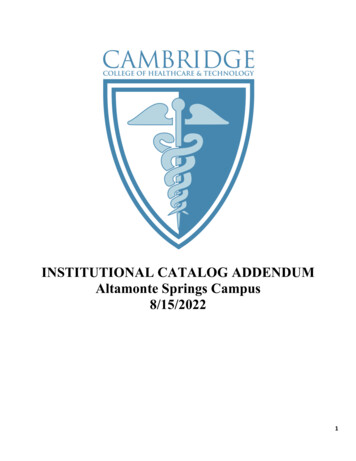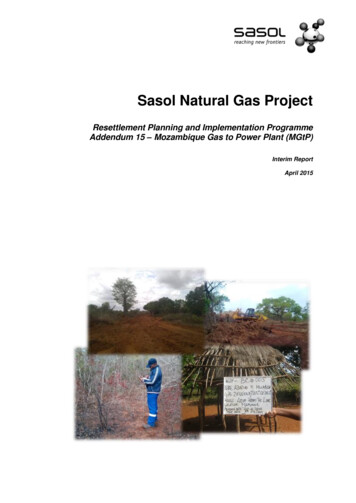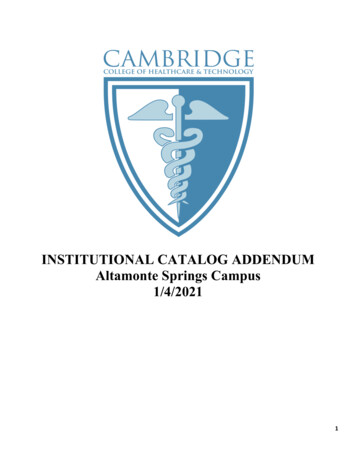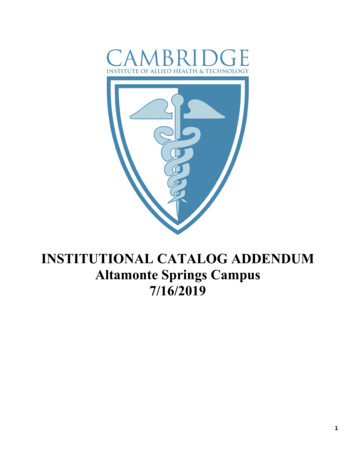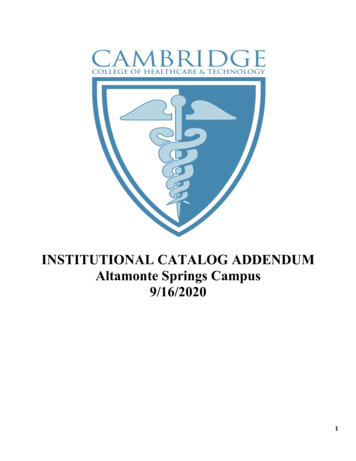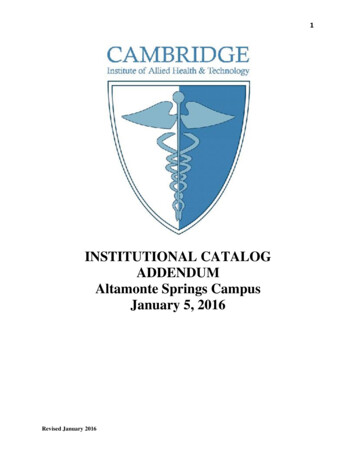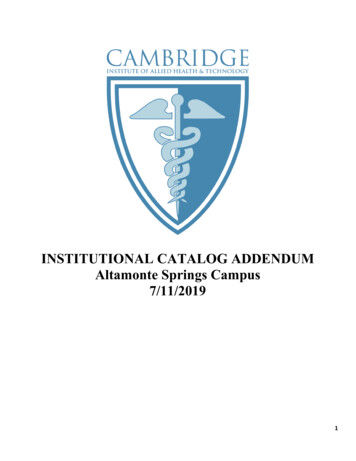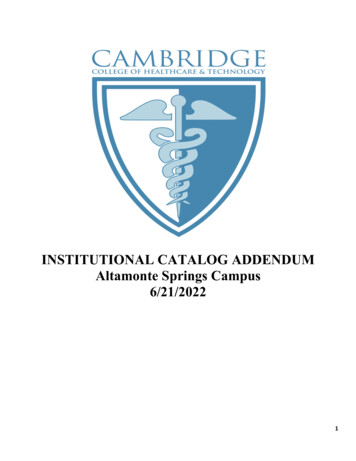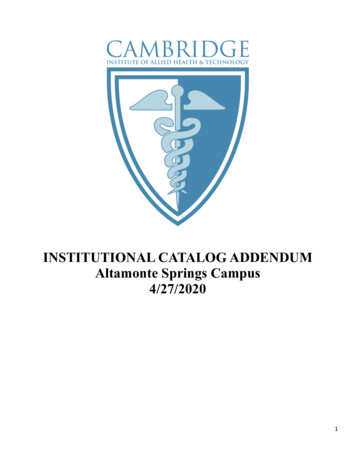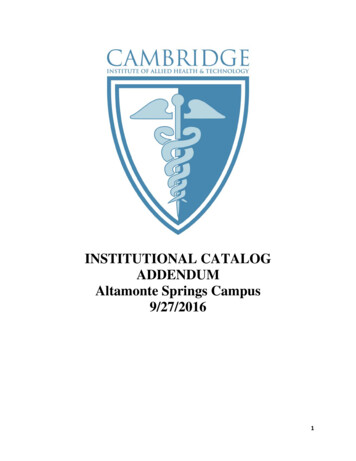
Transcription
INSTITUTIONAL CATALOGADDENDUMAltamonte Springs Campus9/27/20161
FACULTY & ADMINISTRATION:CORPORATE ADMINISTRATIONDr. Terrence W. LaPier, Ph.D. - PresidentDavid Colozzi-Chief Operating OfficerJulie Orloff, M.Ed., CMA, RMA, CPC – Vice President of Compliance & RegulatoryLaura Selvey – Corporate Director of Financial AidDominique Werner – Corporate RegistrarAdrian Rorie, BBM – ControllerCAMPUS ADMINISTRATIONDr. Vicente Quinones - Campus Director – Full TimeGordon Hunt – Director of Admissions – Full TimeSilvana Junike - Financial Aid Manager – Full timeKristie McCarthy – Registrar – Full TimeTheresa Mantovani - Career Services Director – Full TimeHeather Arrington - LibrarianEDUCATIONDr. Jennifer L. Norton RT(R), DOM – Full TimeNiagara County Community CollegeSanborn, New YorkFlorida College of Integrative MedicineOrlando, FloridaMedical Assistant Program DirectorYolande Bain, LPN – adjunctValencia Community College, Orlando FL.AS General EducationPN, Lincoln Technical, Orlando FL.Nursing Assistant Clinical InstructorCarmen Brown, RN, BSN - adjunctCentral Michigan University, MichiganMedgar Evers College, New YorkNursing Assistant InstructorMarsha Pearce, LPN – Full TimeSeminole Community CollegeSanford, FloridaPatient Care Technician InstructorStephanie Bain, BSN, RN-adjunctJacksonville University, FLLake Sumter Community College, FLPractical Nursing Instructor2
Elenor Sims, RN – adjunctBS Nursing – Edinboro University – PennsylvaniaRebecca Henkins, RN – adjunctBS Nursing – University of Central Florida – FloridaAS Nursing – Seminole Community College – Sanford FloridaDuane Carr, RN - adjunctNursing – Valencia Community College – Orlando, FLPhlebotomy InstructorAngelita Davis, CPT - adjunctCentral Florida Regional Hospital, Sanford Fl.Phlebotomy InstructorFiona Mackay, RN, MSN - adjunctChamberlain College of Nursing, OnlinePractical Nursing InstructorMohammad Hassan Khan, NP - adjunctFIU – Master of Science Nursing—Miami, FLFIU – Bachelors of Science Nursing – Miami, FLPractical Nursing InstructorSkye Roberts, RN, BSN - FulltimeBethune-Cookman University—Daytona Beach, FLPractical Nursing Clinical CoordinatorSamantha Paramesvaran, BSN, MSN - adjunctJohns Hopkins University—Baltimore, MDUniversity of Central Florida—Orlando, FLPractical Nursing InstructorMegan Crane, RN, MSN – adjunctMasters – University of Central Florida, OrlandoBSN – University of Florida, GainesvillePractical Nursing InstructorCaron Drake, BSN, RN - adjunctBachelors-Nursing-Union College-Lincoln, NebraskaPractical Nursing InstructorLaura Dana, ASN, RN, MSN - Program Director - FulltimeMSN – Walden UniversityBSN – University of Central FloridaASN – Seminole State College3
Laura Ann Steward, MSN, RN- adjunctMSN-Florida Southern College, FLASN-East Arkansas Community College, ARAshanti Johnson, MSN, RN- adjunctMSN- University of Central FloridaBSN- University of Central FloridaJudeline Docteur, MSN, RN –adjunctMSN-University of South FloridaBSN- University of South FloridaBetty Ann Hodge, MSN, RN – adjunctMSN – University of Central FloridaBSN – University of Central FloridaAAS – Manhattan Community College, NYGeneral Education InstructorsSarah E Neel, MS-adjunctMS Biotechnology University of Central FloridaBS Biology Georgia Institute of TechnologyTheresa Madison, PhD adjunctBarry University – Miami Florida – Leadership Education and CounselingUniversity of Georgia – Georgia – Masters in Social WorkGeorgia State – Georgia - Bachelors in Social WorkClayton College, Ga – AS in PsychologyVocational Technical Center – Orlando – Medical Assistant – DiplomaColette Purcell, MBA adjunctNova Southeastern University, South Florida – Masters in Business AdministrationAtlantic Union College – South Lancaster, Mass – Bachelors in computer Information SystemsUrsula Scott, PhD adjunctCapella University – Online – PhD in Higher EducationNova Southeastern University – online – Masters in EnglishSouth Carolina State, Orangeburg SC – BA in Professional EnglishAvner Stein, MBAUniversity of South Florida – Tampa, FL – MBAUniversity of Florida – Gainesville, FL – Bachelors in Computer, Information Science4
ACADEMIC SCHEDULEThe following dates are potential start dates for each program of study and the expectedcompletion date. These dates are subject to change, according to enrollment numbers andchanges in a student’s progression through the program.PROGRAM START CALENDARPROGRAMPatient Care TechnicianNursing AssistantPhlebotomyPractical NursingPractical NursingAssociate of Science in NursingSHIFTSTART DATEANTICIPATED yDayDayDayEveDayAssociate of Science in Radiologic SciencesDay1/9/201712/21/2018RN to BSNDay1/9/20175/4/2018Medical Billing and Coding (online)Day1/9/2017Medical AssistantDay8/2/20167/28/20178/29/20168/8/20175
17/2017Scheduled Breaks:Spring 2016:March 21-25Summer 2016: July 4-8Winter 2016: December 19-30 January 2-6Holiday ScheduleStudents do not attend class on the following holidays:New Year’s DayMartin Luther King, Jr. DayPresident’s DayMemorial DayIndependence Day (Observed)Labor DayVeterans DayThanksgiving Day & day after Thanksgiving DayChristmas Eve & Christmas DayHours of OperationMonday thru Friday 8:30am – 10:00pmTuitionProgramApplication FeeTuitionMedical AssistantAS in NursingPhlebotomyPractical NursingNursing AssistantPatient CareTechnicianAs in RadiologicScienceRN to BSNMedical Billing andCoding (online) 50.00** 50.00** 50.00** 50.00** 50.00** 50.00** 14,000.00 46,750.00 1,916.00 21,825.00 1,056.00 11,840.00Other Fees not inTuition 30.00 Grad Fee 30.00 Grad FeeN/A 30.00 Grad FeeN/A 30.00 Grad Fee 50.00 38,059.00 30.00 Grad Fee 50.00 50.00 28,000.00 14,300.00 30.00 Grad Fee 30.00 Grad Fee6
The above tuition prices include the cost of textbooks, one set of scrubs & lab fees.** Indicated all application fees are Non RefundableInsert to the Catalog Withdrawal Policy – Page 9Withdrawal PolicyOfficial Withdrawal:A student who wishes to officially withdraw must notify the office of the Registrar via email,certified mail or in person.Unofficial Withdrawal:Credit Hour Programs: If a student misses eight (8) consecutive scheduled classes, the studentwill be automatically terminated without the opportunity to appeal.Clock Hour Programs: If a student misses five (5) consecutive scheduled classes, the student willbe automatically terminated without the opportunity to appeal.Students attending only online classes: If a student does not submit any coursework for 14consecutive calendar days, the student will be automatically terminated without the opportunityto appeal.Insert to the Catalog Refund Policy – Page 11REFUND POLICYStudents withdrawing from the Institute must comply with the policies and procedures as definedin the catalog. Students will be responsible for all tuition & fees for each semester they arepresently attending in addition to any prior account balance. Cambridge Institute chargesstudents tuition and fees by semester. All books, equipment, supplies uniforms and othermiscellaneous items are included in tuition and non-refundable. A detailed schedule of fees andcharges associated with the programs offered are included in the catalog. Tuition retained iscalculated as shown below: Withdrawing at any time during the first week of the semester- 90% refund of tuitiononly.Withdrawing at any time after the first week but within the first 3 weeks of the semester85% refund of tuition onlyWithdrawing at any time after the first 3 weeks but within the first quarter of thesemester- 75% refund of tuition only.Withdrawing at any time during the second quarter of the semester- 50% refund of tuitiononly.Withdrawing at any time during the third quarter of the semester- 10% refund of tuitiononly.Withdrawing at any time during the last quarter of the semester- no refund of tuition.7
RETURN OF TITLE IV FUNDS POLICYFederal Law specifies how the school must determine the amount of FSA program assistancethat a student earns if the student withdraws. The law requires that, when withdrawing during apayment period or period of enrollment, the amount of Student Financial Aid program assistanceis earned up to that point is determined by a specific formula. Cambridge Institute defines apayment period by a semester. If a student received (or the school received on the studentsbehalf) less assistance than the amount that is earned, the student may be able to receive thoseadditional funds. If more assistance was received than was earned, the excess funds must bereturned. This process must be completed within 45 days of the date of determination that astudent has withdrawn and returns will be made according to Federal Guidelines.The amount of assistance that is earned is determined on a pro-rata basis. That is, if a studentcompleted 30% of the payment period or period of enrollment, he/she earns 30% of theassistance originally scheduled to be received. Once a student completes more than 60% of thepayment period or period of enrollment, all of the assistance is earned.If a student received excess funds that must be returned, the school must return a portion of theexcess equal to the lesser of: The institutional charges multiplied by the unearned percentage of the funds, Or the entire amount of the excess funds.If the school is not required to return all of the excess funds, the student must return theremaining amount.Any loan funds that a student must return, the student (or the student’s parent for a PLUS loan)repays in accordance with the terms of the promissory note. That is, the student (or student’sparent) makes scheduled payments to the holder of the loan over a period of time.If a student is responsible for returning grant funds, he/she does not have to return the fullamount. The law provides that a student is not required to return 50% of the grant assistancereceived. Any amount that a student has to return is a grant overpayment, and the student mustmake arrangements with the school, or the Department of Education to return the funds. Failureto return any funds due will result in loss of further Title IV eligibility.The order of repaying funds being returned is as follows:1.Unsubsidized Direct Stafford Loan2.Subsidized Direct Stafford Loan3.Federal Perkins Loan4.Federal PLUS Loan5.Direct PLUS Loan6.Pell Grant7.FSEOG8
Update to SAP Policy Page 13 of the CatalogSTANDARDS OF SATISFACTORY ACADEMIC PROGRESS (SAP)According to federal regulations, students participating in the federal financial aid program atCambridge Institute must meet our Standards of Satisfactory Academic Progress (SAP). TheSAP calculation uses cumulative credit/hour totals.Definition and Purpose of Satisfactory Academic Progress (SAP)Satisfactory Academic Progress (SAP) is measured in both qualitative and quantitativecomponents. SAP is defined as a method of determining student eligibility for assistance under aTitle IV, HEA program, and applies reasonable standards for measuring whether an otherwiseeligible student is maintaining satisfactory progress in his or her educational program.There are three standards that are used to measure academic progress for financial aid purposes:Standard 1-Qualatative: Cumulative grade point average (GPA) is at or above 2.0 for all studentswith the exception of Nursing, which requires a cumulative grade point average (GPA) at orabove 2.8.Standard 2-Quantitative (Pace of Progression): Cumulative completion rate is at or above 67%Students must successfully complete at least 67% of their cumulative attempted credit/clockhours to stay on pace with the Maximum Time Frame requirements. Anytime a studentwithdraws, fails, and/or repeats a class, it is counted as attempted but not completed for thismeasurement. For example, if a student has attempted 24 cumulative credit hours, but onlycompleted 12 cumulative credit hours, this equates to a 50% completion rate.Standard 3-Maximum Timeframe: Credits/clock hours completed and/or attempted does notexceed 150% of the credits/clock hours required to complete the program Financial aid recipientsare required to complete their program within 150% of the published length of the program asmeasured by the cumulative number of credit/clock hours the student is required to complete andexpressed in calendar time. (Note that a student in a clock hour program cannot receive aid forhours beyond those in the program; the maximum timeframe applies to the amount of calendartime the student takes to complete those hours.) Students become ineligible for Title IV aid in thecurrent program of study when it becomes mathematically impossible to complete the programwithin 150 percent of the length of the program, even when the student has not yet reached 150percent.Course incompletes (I), Withdrawals (W/WF) and RepetitionsGrades including Incomplete (I), Fail (F), and Withdrawn (W/WF) are defined as unsuccessfulcompletion. Accordingly, these courses count as the applicable credits/hours attempted and countas zero credits/hours earned in the SAP calculation. The grade of “F” additionally counts as zeroquality points when the qualitative SAP standard is assessed. Grades of I and W/WF are notcounted when the qualitative SAP standard is assessed. Grades of I and W/WF do not carry anyquality points. Students who have a grade of incomplete that results in an unsatisfactorystanding, may have their SAP status recalculated when they subsequently complete the courserequirements those grades are later reported. Students who achieve satisfactory standing as theresult of a grade recalculation will be evaluated for reinstatement of financial aid so long as allother eligibility criteria are met. The grade earned in a repeated course will be substituted for the9
original grade, if higher, in computing the grade point average for SAP.Transfer CreditsTransfer credits that count toward the student’s current program are counted as both attemptedand completed hours in the quantitative measures.The SAP ReviewA review of SAP requires that both the qualitative and quantitative measures be reviewed. We will count all credits/clock hours that appear on a student’s transcript as cumulative hoursattempted and/or completed. If a student is enrolled in a credit granting program, we will calculate all standards at the end ofeach term. If a student is enrolled in a clock hour program, we will calculate all standards at the timehe/she successfully completes the required hours in a payment period.NotificationStudents are notified via email when they have not met SAP requirements. The student is thenrequired to meet with the Registrar and Program Official to discuss requirements for meetingSAP.SAP ViolationsIf a satisfactory progress check shows that a student does not have the required GPA or is notmaintaining the required pace, the following actions will occur: First violation: Student to be placed on SAP Warning status until the next check. During thistime, the student will be eligible for aid. If the student is meeting SAP standards at the nextcheckpoint, the student will return to good standing. Second consecutive violation: At this time, the student will be placed on SAP Termination andwill not be eligible for aid unless they successfully appeal. If appeal is successful, student will beplaced on SAP Probation status until the next checkpoint.SAP Termination- Students whose eligibility has been terminated (because of failure to meetthe standards of satisfactory progress) that do not appeal, will not be eligible to receive aid, butmay maintain enrollment. Student will be required to pay for their own classes until they haveearned the minimum required GPA and/or completion rate. Students will not be reimbursed forcourses taken while ineligible for aid. Eligibility will be regained once a student is found to bemeeting both the Quantitative and Qualitative SAP standards, but while not exceeding theMaximum Time Frame.Students whose eligibility has been terminated (because of failure to meet the standards ofsatisfactory progress) may, in certain cases, appeal their suspension of eligibility. Circumstancesthat may be considered for this special review (appeal) include: illness of student and/orimmediate family member (mother, father, sister, brother, spouse), death of immediate familymember and relocation due to military duty or employment. If there are extenuatingcircumstances that caused the student to fail SAP, the student may file an appeal. A studentwhose appeal is approved will have financial aid eligibility reinstated on a Probationary basis forone payment period. The student may continue to receive financial aid during this ProbationaryPeriod but must meet the regular SAP standards or be making progress under an approved10
improvement plan by the end of the Probationary Period. By the end of that term/paymentperiod, your academic credentials must meet SAP standards. Appeals are not retroactive.Procedure for SAP AppealAppeals are to be submitted to the Registrar’s office. The Registrar will provide the appeal to theAcademic Affairs Committee for a final decision. In order to appeal the decision on this basis;the following procedures must be used:1. Complete SAP Appeals Form.2. Type an appeal letter, or print legibly. Make sure to include a detailed explanation of thecircumstances that occurred.3. Provide documentation from a third party to support the appeal.4. Be sure that the circumstances referenced apply to the term/payment period for which thestudent is claiming mitigating circumstances.5. Once your appeal has been reviewed the student will be notified of the result by email.Update to the Catalog Page 27 Drug and AlcoholPolicyDRUG FREE CAMPUS AND WORKPLACE POLICYCambridge Institute of Allied Health and technology is committed to providing a drug-freecampus and workplace environment. As an institution of higher education, the Collegerecognizes the need to establish a drug and alcohol awareness program to educate faculty,staff and students about the dangers of drug and alcohol abuse. This policy is established asrequired by the Drug-Free Workplace Act of 1988 and the Drug-Free Schools andCommunities Act of 1989.DRUG FREE AWARENESS PROGRAMAll employees and students are informed that the college has established a Drug Free AwarenessProgram informing students and employees via institutional catalog and posted flyers on campusabout: Our policy of maintaining a drug-free school; Any available drug counseling, rehabilitation, and student assistance programs; and The penalties that may be imposed upon students for drug violations occurring oncampus property, as defined in the sanctions section below. Available referral to drug counseling and rehabilitation for employees can beobtained through United Way and students may contact the United Way for11
counseling and rehabilitation at 211 or www.211.org. A list of resources is alsoavailable in Appendix V.POSSESSION, SALE AND/OR CONSUMPTION OF NON-PRESCRIPTION ANDILLEGAL DRUGSNo student may be in illegal possession of, deliver, dispense, distribute, administer,manufacture or wholesale any controlled substance, including marijuana, narcotics,hallucinogens, and other chemical analog or drug-related paraphernalia prohibited by State orFederal Drug Laws. (Federal law requires that students be informed that Federal and Statelaws prohibit possession and/or use of illicit drugs. Cambridge Institute complies withFederal and State laws regarding illicit drugs. The campus reserves the right to investigate anysuspicious activity regarding nonprescription and illegal drugs. Investigation may include butis not limited to classroom and/or vehicle inspection, canine drug scan or drug screening incases of strong suspicion of drug use. (Refusal to submit to these measures at time ofrequest may be viewed as strong evidence, which may result in suspension.)Cambridge Institute has a “Zero-Tolerance” policy regarding the unlawful use, sale, possessionor distribution of illegal drugs and alcohol on School property, or as part of any School activity.Misconduct violations relating to the Student, Faculty and/or Employee Codes of Conduct aresubject to disciplinary actions. Consequences for inappropriate behavior can be severe, up toand including dismissal from the college. If any individual is apprehended for violating anyalcohol or other drug related law while at a college location or activity, the college will fullycooperate with federal and state law enforcement agencies. The college abides by federal DrugFree Workplace and Drug-Free Schools and Communities Act regulations regardless ofindividual state legalization.SANCTIONSThe following are prohibited under the Code of Conduct applicable to students: Use, possession or distribution of narcotic or other controlled substances, except asexpressly permitted by law, or being under the influence of such substances. Use, possession or distribution of alcoholic beverages, except as expressly permitted bylaw and Cambridge College regulation.The sanctions listed below may be imposed upon any covered person found to have violated theCode of Conduct. The listing of the sanctions should not be construed to imply that coveredpersons are entitled to progressive discipline.The sanctions may be used in any order and/or combination that Cambridge Institute deemsappropriate for the conduct in question.a. Warning - A verbal or written notice that the respondent is in violation of or has violatedCambridge Institute regulations.b. Probation - A written reprimand with stated conditions in effect for a designated period oftime, including the probability of more severe disciplinary sanctions if the respondent isfound to be violating any Cambridge Institute regulation(s) during the probationary period.12
c. Cambridge Institute Suspension – temporary separation of the respondent from allCambridge Institute locations.d. Cambridge Institute Expulsion - Permanent separation of the respondent from allCambridge Institute locations.Faculty and StaffFaculty and Staff of the institution are prohibited from: Performing school business under the influence of a controlled substance. Possession, use, sale of a controlled substance. Furnishing a controlled substance to a minor.Sanctions for these violations could lead up to termination of employment. These sanctions are inaddition to any criminal sanctions that may be imposed.STATE STATUTESThe State Statutes that govern sale and consumption of alcoholic beverages for both Florida andGeorgia are listed in Appendix IV.DESCRIPTION OF HEALTH RISKSThe following are descriptions of dangerous drugs:Drugs and/or alcohol use contribute to (Nature 2010; 468:475): 33% of all suicides 33% of all fatal motor vehicle accidents 50% of all homicidesAlcohol is a potentially addictive drug of significant physical and psychological consequence.Alcohol is a central nervous system depressant that affects all neurological functions. At relativelylow levels it affects ones judgment and decision-making, and at higher levels it impairs thefunctioning of one’s vital organs and can result in a coma or death. Alcohol is an irritant to thegastrointestinal tract and moderate overindulgence ordinarily results in nausea, vomiting, anddiarrhea. In addition to these significant physical consequences, there are a number of lessobvious consequences to alcohol use. For example, the effects of alcohol on sleep have been welldocumented. Consuming several drinks before bedtime has been found to decrease the amount ofREM (rapid eye movement) or dreaming sleep. The consequences of being deprived of REMsleep are impaired concentration and memory, as well as anxiety, tiredness, and irritability.Additionally, research has demonstrated that alcohol tends to decrease fear and increase thelikelihood that an individual will accept risks. This lack of inhibition and judgment is a majorcontributor to the extraordinarily high percentage of serious accidents and accidental deathsrelated to alcohol use. Prolonged and excessive use of alcohol usually causes progressively moreserious erosion of the gastrointestinal tract lining ranging from gastritis to ulcers and hemorrhage.Damage to the pancreas is frequent among those who have used alcohol. Interestingly, while 10%13
of the adult population is estimated to be addicted to beverage alcohol, (i.e., they are alcoholics),this 10% of the population comprises 35% of those hospital in-patients who receive major surgeryin any given year. Alcoholism is the third major killer in the United States, second to heart diseaseand cancer, and acute alcohol intoxication is the second leading cause of death by poisoning.Marijuana (Cannabis) (nicotina glauca) is an illegal drug that impairs memory, perception,judgment, and hand-eye coordination skills. The tar content in cannabis smoke is at least 50%higher than that of tobacco and thus smokers run the added risk of lung cancer, chronicbronchitis, and other lung diseases. Recently, the medical community has diagnosed theexistence of an AA motivational syndrome that affects moderate to chronic users and includessymptoms of loss of energy, motivation, effectiveness, concentration, ability to carry out longterm plans, and performance in school and work.LSD (Lysergic Acid Diethylamide) is a semi-synthetic drug regarded as a hallucinogenic.Short-term effects of this drug are generally felt within an hour of consumption and may lastfrom two to 12 hours. Physiologically the user experiences increased blood pressure, rise inbody temperature, dilated pupils, rapid heartbeat, muscular weakness, trembling, nausea, chills,numbness, loss of interest in food, and hyperventilation. Fine motor skills and coordination areusually impaired, as are perception, thought, mood, and psychological processes. Long-termeffects may include flashbacks, weeks and even months after taking the drug, mental illness,prolonged depression, anxiety, psychological dependence, and suicidal thoughts.PCP (Phencyclidine Hydrochloride) is a white crystalline powder that was originally used as alocal anesthetic, but due to extreme side effects, was discontinued in 1967. In humans, PCP is adifficult drug to classify in that reactions may vary from stupor to euphoria and resemble theeffects of a stimulant, depressant, anesthetic, or hallucinogen. Short-term effects includehyperventilation, increase in blood pressure and pulse rate, flushing and profuse sweating,general numbness of the extremities, and muscular in coordination. At higher doses it causesnausea, vomiting, blurred vision, loss of balance, and disorientation. It produces profoundalteration of sensation, mood and consciousness, and can cause psychotic states in many waysindistinguishable from schizophrenia. Large doses have been known to cause convulsions,permanent brain damage, and coma.Psilocybin is a hallucinogenic drug occurring naturally in about 20 species of Mexicanmushrooms and is also produced synthetically. It is a white powder made of fine crystals anddistributed in tablet, capsule, or liquid form. Shortly after taking psilocybin, a user mayexperience increased blood pressure, rapid heartbeat, and an increase in body temperature, drymouth, dilated pupils, and some degree of agitation or excitement. This is followed by adecrease in the ability to concentrate or stay in touch with reality. (Hallucinations, as well asaltered perceptions of time and space, may occur.) The effects are usually shorter lasting thanthose of LSD, yet the dangers are very similar.Cocaine is a naturally occurring stimulant drug which is extracted from the leaves of the cocoaplant. Cocaine is sold as a white translucent crystalline powder frequently cut to about half itsstrength by a variety of other ingredients including sugars and cleaning powders. It is one of themost powerfully addictive drugs in use today. Short-term effects of cocaine include constricted14
peripheral blood vessels, dilated pupils, increased heart rate and blood pressure. It also causesappetite suppression, pain indifference, possible vomiting, visual, auditory, and tactilehallucinations, and occasionally paranoia. Long-term effects include nasal congestion, collapseof nasal septum, restlessness, irritability, anxiety, and depression. Overdoses or chronic use mayresult in toxicity which includes symptoms of seizures followed by respiratory arrest, coma,cardiac arrest, and/or death.Cocaine Free-Base or Crack is the result of converting street cocaine to a pure base byremoving the hydrochloric salt in many of the “cutting” agents. The end result is not watersoluble, and therefore, must be smoked. It is much more dangerous than cocaine because itreaches the brain in seconds, and the intensified dose results in a sudden and intense physicalreaction. This response lasts a few minutes and is followed by deep depression, loss of appetite,difficulty in sleeping, feeling revulsion for self, and worries and obsessions about getting morecrack. Consequently, users often increase the dose and frequency of use resulting in severeaddiction that includes physical debilitation and financial ruin. Physiologically, seizuresfollowed by respiratory arrest and coma or cardiac arrest and death may accompany long-termuse.Amphetamines are central nervous system stimulants that were once used medically to treat avariety of symptoms including depression and obesity. They may be taken orally, sniffed, orinjected into the veins. Short-term effects disappear within a few hours and include reduction ofappetite, increased breathing and heart rate, raised blood pressure, dilation of pupils, dry mouth,fever, sweating,
Gordon Hunt - Director of Admissions - Full Time . Silvana Junike - Financial Aid Manager - Full time . . Medgar Evers College, New York . Nursing Assistant Instructor . Marsha Pearce, LPN - Full Time . Seminole Community College . Sanford, Florida . Patient Care Technician Instructor
